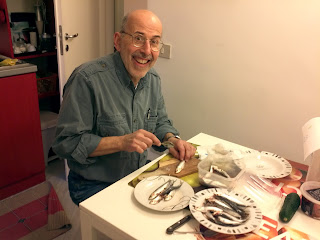You guessed it, back to Il Ballarò!!
It's Saturday and all of Palermo must be shopping Il Ballarò. It was mobbed. It was frenetic. Vendors were shouting. "Come here! We've got the best and freshest artichokes!" The rain was torrential. The water poured down folds in the awnings and collected in small streams that fell from the center and sides. Not only were people dodging these streams, but they were dodging the umbrellas that people insisted on using. But Tony and I were clever. We donned the hoods of our raincoats and just scurried about. Ohh, what a pleasure to return home.
Today we're going to try a TRUE Sicilian dish - Beccafico, fresh sardines stuffed with herb-orange flavored breadcrumbs.
The sardines are truly fresh and we've boned, filleted and stuffed about 30 while it poured.
But first, Tony must do his daily work-out!
Now that dinner is prepared and the rain has abated, we're off to visit more of Palermo.
 First, the Cathedral.
First, the Cathedral. Built in 1185, like most Sicilian churches, it was built upon existing Greek, Roman, Arab and early Christian churches. The bell towers were added in the 1300's and the interior radically remodeled in the late 1700's.
It is the largest church in Sicily.

Sunday service at the Cathedral
On the church's bulletin board we found a notice indicating the beatification of Don Giuseppe Puglisi, killed by the Mafia in 1993.
Piazza Pretoria nicknamed by the locals, Piazza della Vergogna (Square of Shame).
It was built during the Inquisition, 1555, and was considered shameful because of its 16 "nude" statutes of nymphs, men, sirens and satyrs.
San Cataldo - Built in 1143 in the Arab Norman style, it was the chapel of a 12th c. palazzo. It is distinctly marked by 3 red Arabic styled domes. The interior is simple and was never
architecturally modified.
La Martorana (Church of Santa Maria dell'Ammiraglio)
Of Norman origin (1105-1154) with 12th c. mosaics. Except for the mosaics, the interior was extensively and ornately altered during the Baroque period - see the altar.
It has an interesting entrance through the bell tower.
Palazzo dei Normanni
Originally a Norman royal palace, today it is the seat of the regional parliament of Sicily.
Porta Nuova
One of the main gates into the city and one of the largest.
It was constructed in 1569 to commemorate the entry (in 1535) of Charles V into Palermo and his victory over the Moors.
The Eagle in the pyramid shaped crown (made of majolica tile) is a symbol of the Sicilian Senate.
The entrance is decorated with "telamoni" (figures of men). This is a common feature in many Greek temples.
San Domenico
The Baroque façade was installed 1724
From the rooftop of a mall located across the street, we had a magnificent view of the Palermo mountains. Much like Rio di Janeiro, the city is located at the mouth of a large bay and is encircled by mountains. A spectacular sight.































No comments:
Post a Comment